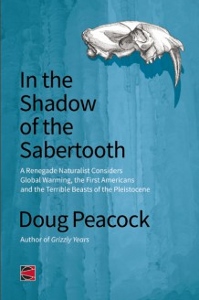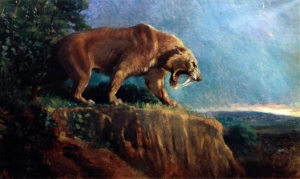The First American Adventure…
Author: Doug Peacock
 It may have been the greatest adventure in human history. Traveling from eastern Asia, following the last great ice age, courageous bands of modern humans found two massive uninhabited continents for the taking. Upon their arrival, ten to twenty thousand years ago, the land was full of fearsome new predators like the saber-tooth cat, the American lion and the short-faced bear – standing at 15 feet tall, the largest terrestrial predator in Earth’s history. There were also plenty of other strange creatures, like five ton ground sloths, giant mammoths and mastodons, even a 350 pound species of beaver. While the reality of human colonization of the Americas is not in dispute, the details are anything but clear, given the paucity of archeological data. Inspired by the image of intrepid human hunters facing this daunting challenge with nothing but their wits, writer and naturalist Doug Peacock has contributed In the Shadow of the Sabertooth, his personal take on these prehistoric exploits.
It may have been the greatest adventure in human history. Traveling from eastern Asia, following the last great ice age, courageous bands of modern humans found two massive uninhabited continents for the taking. Upon their arrival, ten to twenty thousand years ago, the land was full of fearsome new predators like the saber-tooth cat, the American lion and the short-faced bear – standing at 15 feet tall, the largest terrestrial predator in Earth’s history. There were also plenty of other strange creatures, like five ton ground sloths, giant mammoths and mastodons, even a 350 pound species of beaver. While the reality of human colonization of the Americas is not in dispute, the details are anything but clear, given the paucity of archeological data. Inspired by the image of intrepid human hunters facing this daunting challenge with nothing but their wits, writer and naturalist Doug Peacock has contributed In the Shadow of the Sabertooth, his personal take on these prehistoric exploits.
Peacock’s own life is also quite the adventure. Serving as a Green Beret combat medic during the Vietnam War, he returned and sought solace in the isolation of American West, spending time in close contact with numerous grizzly bears, eventually writing about the experience in Grizzly Years(1990), a book that moved me many years ago. Despite his lack of formal training, he has gone on to become one of the world’s foremost grizzly experts, sometimes branching out to explore the lives of other large predators – polar bears, Siberian tigers, Alaskan brown bears. It’s this personal and unique passion that he brings to his writing that prompted me to grab this book. I was not disappointed.
It’s not an exaggeration to say that all of the details of humanity’s first arrival in the New World are in dispute. Did they travel in boats down the west coast of North America, feasting on the abundant fish and mollusks along the way? Did they quickly travel down the ice free corridor between the massive ice sheets covering the northern half of the continent, hunting elk and other large herbivores? A few hold outs still argue for visitors from across the Atlantic. All of the above is a possible answer. Peacock sorts through the variations on these hypotheses, providing some detailed speculation about what the adventures may have been like for our protagonists.
Other mysteries persist. How did they defend themselves against the terrifying large cats, bears and wolves they encountered? How did they keep these same beasts from stealing their dinner? It’s hard to see how a few rocks and pointed sticks were going to suffice. Peacock uses his deep understanding of modern predators to conceive how the earliest Americans may have done it.
The most vibrant controversy surrounds the Clovis culture – mammoth hunting specialists and creators of the most technologically sophisticated stone projectile points of the Stone Age – who appeared suddenly about 13,000 years ago, spread across most of the continent, decimated much of the North American megafauna and just as rapidly disappeared, all in the span of several hundred years. Were they the first ones here, or did other less robust groups precede them? What were the encounters between groups like? Why did Clovis die out so quickly? What impact did contemporary climactic changes have? The archeological data delivers few definitive answers, mostly providing fuel for heated arguments. The author provides plenty of interesting ideas from his unique perspective.
Peacock exhibits an abiding respect for ancient North Americans and the unique challenges they faced, which makes for some truly entertaining and intellectually stimulating reading. The fact that he bases many of his hypotheses on his own experiences in similar situations, while incorporating plenty of scientific data, makes this much more than just another science book. He also draws parallels between the climate crises impacting present day humanity and the earliest Americans, wondering if modern humans could learn a thing or two from our ancient ancestors.
In the end, In the Shadow of the Sabertooth is a unique look at one of humanity’s great adventure stories. Skillfully told by a naturalist with a distinctive approach to the many ancient mysteries that remain, I can strongly recommend this book for anyone interested in good nature writing or important archaeological enigmas.
— D. Driftless
Clovis point photo by locutus borg
- Best Non-Fiction of 2016 - February 1, 2017
- Little Free Library Series — Savannah - May 22, 2015
- Little Free Library Series — Wyoming - November 30, 2014




Leave A Comment